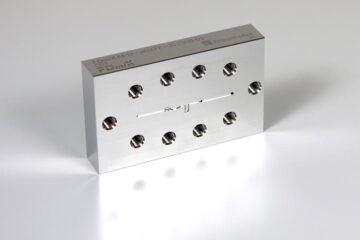Now we’re cooking with lasers

Chicken being cooked by a blue laser. Light is being directed by two software-controlled mirror galvanometers.
Credit: Jonathan Blutinger/Columbia Engineering
Columbia Engineers invent software-controlled robotic lasers that cook food with unparalleled precision, retaining more moisture, and creating an entirely new, customized way to cook a tasty meal.
Imagine having your own digital personal chef; ready to cook up whatever you want; able to tailor the shape, texture, and flavor just for you; and it’s all at the push of a button. Columbia engineers have been working on doing just that, using lasers for cooking and 3D printing technology for assembling foods.
Under the guidance of Mechanical Engineering Professor Hod Lipson, the “Digital Food” team of his Creative Machines Lab has been building a fully autonomous digital personal chef. Lipson’s group has been developing 3D-printed foods since 2007. Since then, food printing has progressed to multi-ingredient prints and has been explored by researchers and a few commercial companies.
“We noted that, while printers can produce ingredients to a millimeter-precision, there is no heating method with this same degree of resolution,” said Jonathan Blutinger, a PhD in Lipson’s lab who led the project. “Cooking is essential for nutrition, flavor, and texture development in many foods, and we wondered if we could develop a method with lasers to precisely control these attributes.”
In a new study published Sept. 1, 2021, by npj Science of Food, the team explored various modalities of cooking by exposing blue light (445 nm) and infrared light (980 nm and 10.6 μm) to chicken, which they used as a model food system. They printed chicken samples (3 mm thick by ~1in2 area) as a test bed and assessed a range of parameters including cooking depth, color development, moisture retention, and flavor differences between laser-cooked and stove-cooked meat. They discovered that laser-cooked meat shrinks 50% less, retains double the moisture content, and shows similar flavor development to conventionally cooked meat.
Video 01 — Robots that Cook: precision cooking with multiwavelength lasers
Video 02 — Precision Cooking with Multiavelength Lasers: temperature data
“In fact, our two blind taste-testers preferred laser-cooked meat to the conventionally cooked samples, which shows promise for this burgeoning technology,” Blutinger said.
While Lipson and Blutinger are excited about the possibilities of this new technology, whose hardware and software components are fairly low-tech, they note that there is not yet a sustainable ecosystem to support it. Lipson states that “what we still don’t have is what we call ‘Food CAD,’ sort of the Photoshop of food. We need a high level software that enables people who are not programmers or software developers to design the foods they want. And then we need a place where people can share digital recipes, like we share music.”
Still, says Blutinger, “Food is something that we all interact with and personalize on a daily basis–it seems only natural to infuse software into our cooking to make meal creation more customizable.”
About the Study
The paper is titled “Precision Cooking for Printed Foods via Multi-wavelength Lasers.”
Journal: npj Science of Food
Authors are: Jonathan Blutinger, Alissa Tsai, Erika Storvick, Gabriel Seymour, Elise Liu, Noà Samarelli, Shravan Karthik, Yorán Meijers, and Hod Lipson, Departments of Mechanical Engineering and Computer Science, Columbia Engineering.
This work was supported in part by Columbia University’s SEAS Interdisciplinary Research Seed (SIRS) funding program and by NSF NRI Award #1925157.
The authors declare no financial or other conflicts of interest.
LINKS:
Paper: https://www.nature.com/articles/s41538-021-00107-1
DOI: 10.1038/s41538-021-00107-1
Video 01 — Robots that Cook: precision cooking with multiwavelength lasers
https://youtu.be/jct3f92rIOE
Video 02 — Precision Cooking with Multiavelength Lasers: temperature data
https://youtu.be/iHcrQE60Sxg
PROJECT WEBSITE:
https://www.creativemachineslab.com/laser-cooking.html
https://www.creativemachineslab.com/digital-food.html
Columbia Engineering
Columbia Engineering, based in New York City, is one of the top engineering schools in the U.S. and one of the oldest in the nation. Also known as The Fu Foundation School of Engineering and Applied Science, the School expands knowledge and advances technology through the research of its more than 220 faculty, while educating undergraduate and graduate students in a collaborative environment to become leaders informed by a firm foundation in engineering. School’s faculty are at the center of the University’s cross-disciplinary research, contributing to the Data Science Institute, Earth Institute, Zuckerman Mind Brain Behavior Institute, Precision Medicine Initiative, and the Columbia Nanμmo Initiative. Guided by its strategic vision, “Columbia Engineering for Humanity,” the School aims to translate ideas into innovations that foster a sustainable, healthy, secure, connected, and creative humanity.
Journal: npj Science of Food
DOI: 10.1038/s41538-021-00107-1
Article Title: Precision Cooking for Printed Foods via Multi-wavelength Lasers
Article Publication Date: 1-Sep-2021
COI Statement: The authors declare no financial or other conflicts of interest.
Media Contact
Holly Evarts
Columbia Engineering
he2181@columbia.edu
Office: 3474537408
Cell: 3474537408
All latest news from the category: Information Technology
Here you can find a summary of innovations in the fields of information and data processing and up-to-date developments on IT equipment and hardware.
This area covers topics such as IT services, IT architectures, IT management and telecommunications.
Newest articles

For microscopic organisms, ocean currents act as ‘expressway’ to deeper depths
New research shows how tiny plant-like organisms hitch a ride on ocean currents to reach darker and deeper depths, where they impact carbon cycling and microbial dynamics in the subtropical…

FDmiX: Fast, robust series production of nanoparticles
Nucleic acid-based medications such as mRNA vaccines are opening up new therapeutic approaches. These active ingredients must be enclosed inside nanoparticles to ensure that they get to where they are…

Sensor measures oxygen content of breath
Oxygen saturation in the blood that is either too low or too high can cause physical harm or even death. This is why patients’ oxygen concentraions are monitored continuously in…





















